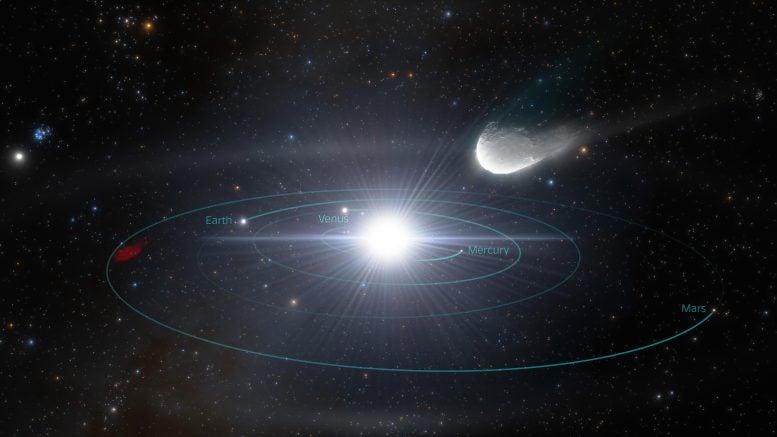"Interstellar Explorers: Rubin Observatory to Uncover Rapidly Moving Objects in Our Solar System"

This artist’s impression illustrates an interstellar object rapidly approaching our Solar System. The object, ejected from its home planetary system long ago, traveled through interstellar space for billions of years before briefly passing through our cosmic neighborhood. Rubin Observatory will reveal many of these previously unknown interstellar visitors. Credit:Rubin Observatory/NOIRLab/NSF/AURA/J. daSilva/ M. Zamani
Vera C. Rubin Observatory’s Legacy Survey of Space and Time will revolutionize Solar System science by revealing a population of previously undiscovered interstellar comets and asteroids passing through our cosmic neighborhood
Many as-yet-undiscovered interstellar objects exist throughout our Milky Way Galaxy: comets and asteroids that have been ejected from their home star systems. Some of these objects pass through our Solar System, bringing valuable information about how planetary systems form and evolve. Currently, only two such interstellar visitors have been discovered: 1I/ʻOumuamua and comet 2I/Borisov. Rubin’s upcoming Legacy Survey of Space and Time will show us many more.
We’ve learned a lot about the biggest, brightest objects in our Solar System using existing instruments and telescopes. However, astronomers like Michele Bannister, Rutherford Discovery Fellow at the University of Canterbury in Aotearoa New Zealand and member of the Rubin Observatory/LSST Solar System Science Collaboration, want to search deeper, for small, faint bodies that originated in planetary systems far beyond our own. These interstellar objects — which were flung from their home systems into the space between stars — are so faint that they have been virtually undetectable. But with the upcoming Legacy Survey of Space and Time (LSST), conducted with Vera C. Rubin Observatory in Chile, scientists are expecting an explosive period of discovery as these faint objects come into view for the first time.
Rubin Observatory is jointly funded by the National Science Foundation (NSF) and the US Department of Energy (DOE). Rubin is a Program of NSF’s NOIRLab, which, along with SLAC National Accelerator Laboratory, will operate Rubin.
This video shows the paths through our Solar System of the two confirmed interstellar objects, ‘Oumuamua (formally known as 1I/2017 U1), discovered in 2017, and the comet 2I/Borisov, discovered in 2019. The paths of these objects are markedly different than the orbits of objects in our Solar System, making them easy to differentiate as interstellar objects. Rubin Observatory and the Legacy Survey of Space and Time will provide data that enables scientists to identify many interstellar objects early in the survey. Credit: Rubin Observatory/NSF/AURA/J. Pinto
The origins of our Solar System lay in a massive swirling cloud of gas and dust that collapsed to form new stars, one of which was our Sun. The stars gobbled up most of the cosmic ingredients, but around each star the remainder formed the small building blocks of planets — called planetesimals — ranging from tens of meters to a few kilometers in size. Some of these coalesced into planets and their moons and rings, but trillions of leftover planetesimals continued to orbit their host stars.
With the aid of observations of our Solar System and computer simulations, scientists speculate that the gravity of larger planets and passing nearby stars often launches most of these remnant planetesimals away from their home systems and out into their galaxies. Traveling through space and not bound to any star, they’re now known as interstellar objects.
This image captures not only Vera C. Rubin Observatory, but one of the celestial specimens Rubin Observatory will observe when it comes online: the Milky Way. The bright halo of gas and stars on the left side of the image highlights the very center of the Milky Way galaxy. The dark path that cuts through this center is known as the Great Rift, because it gives the appearance that the Milky Way has been split in half, right through its center and along its radial arms. Credit: RubinObs/NOIRLab/NSF/AURA/B. Quint
“Planetary systems are a place of change and growth, of sculpting and reshaping,” said Bannister. “And planets are like active correspondents in that they can move trillions of little tiny planetesimals out into galactic space.”




